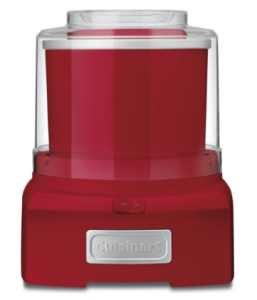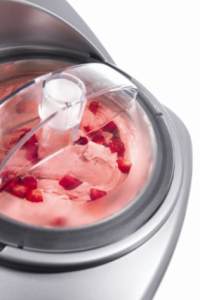Whether it’s served in a cone on a hot day in the summer, or in a parfait during the holidays when the days get short, ice cream is the ultimate treat. While ice cream served at your favorite drive-in stand or out of the freezer case at the supermarket is great, nothing is quite as tasty and fun as ice cream that you’ve made yourself. With today’s wide selection of ice cream makers, there’s no reason not to make your own ice cream out of fresh ingredients and enjoy it even more. Children love to help make ice cream, so a cool treat can become a worthwhile activity at the same time. If you’re on a diet, or just want something lighter, your ice cream maker can also supply you with other frozen treats like frozen yogurt, sorbet, or gelato.
When you make your own ice cream, you can be sure of just how much extra sugar your family is eating, and skip the additives, colorants, and preservatives that most ice cream brands include. While making homemade ice cream is nothing new, the latest ice cream makers on the market make it quicker and easier than ever. Use our handy buying guide to make the perfect selection when you’re shopping for an ice cream maker for your kitchen.
Know the Different Types Before You Shop
Making ice cream isn’t difficult, and there are many different approaches that can be used. Here are the most popular kinds of ice cream makers on the market today:
Traditional Ice Cream Makers
Ice cream has been produced for many decades by using a mixture of ice and rock salt in an outer bucket while a hand crank constantly stirs an inner bucket of milk and cream. You can still make ice cream in this old-fashioned way, or use an electric crank to make production go faster and easier. Hand crank models give an old-timey feeling to the procedure, and kids love to turn the crank, at least for a little while. It’s useful to keep in mind that it takes 20 or 30 minutes of continuous cranking to produce even soft ice cream, so adults often find themselves finishing the batches even if the kids start out strong. Choose an electric crank if you don’t want a workout, but be prepared to watch over the outer bucket continuously to keep it full of ice and salt. Making ice cream with this method is inherently messy, so most users prefer to use it outdoors in the warmer months.
Compressor Ice Cream Makers
Compressors are the machines that make it cool inside your refrigerator, and remove the heat from your house in air conditioning units. Compressors work by circulating a coolant inside an enclosed system that expands when it’s heated, and then expels the heat when it’s compressed. What it offers over other methods is a very quick cooling capacity. Compressor ice cream makers cool off the ice cream production canister very quickly, and it allows the person preparing ice cream to prepare one batch of ice cream after another, without much waiting around for the container to cool off again. That allows you to change flavors with each batch, while you serve everyone almost at the same time.
Gel Canister Ice Cream Makers
Gel canister ice cream makers use a container filled with a substance that requires freezing for up to 24 hours before preparing ice cream in the machine. While it takes a long while for the gel to become cold enough to use, once it’s ready to use, it prepares ice cream as quickly as any method. If you want to prepare more than one batch at a time, choose a larger model with more compartments, as the gel can only be used once before it needs to be re-frozen.
 Soft Serve Ice Cream Maker
Soft Serve Ice Cream Maker
For some people, soft serve ice cream is the best way to enjoy this frosty treat. Soft serve ice cream machines are also great for preparing sherbet, frozen yogurt, and sorbet, so you can always have something cold to tempt any palate. Soft Serve ice cream machines are generally a type of gel canister of compressor unit that’s optimized for the texture of soft serve ice cream, but it’s possible to purchase an attachment for many large kitchen mixers that will do the trick as well. Any version of the soft serve ice cream maker can have the frosty treat ready in as little as 20 minutes.
Ice Cream Balls
If you’re looking for a fun and easy way to make ice cream when you’re on a picnic or enjoying a day at the beach, try an ice cream ball. Ice cream balls are little plastic globes that have screw top openings on both ends. Just put your ice cream ingredients in one end, ice and rock salt in the other, and then roll the ball until ice cream is formed inside. The process is the same as with a traditional cranked ice cream maker, but ice cream balls are more fun, and make less of a mess.
How Ice Cream Makers Work
All ice cream is produced by the same process, but uses different methods to enable the process to happen. The ingredients are combined in a container and constantly stirred, usually by a paddle, or dasher, that scrapes the sides of the container and mixes in a certain amount of air that makes ice cream so smooth. The exterior surfaces are cooled in order to turn the liquid into a solid while it’s being mixed. It normally takes about 20 to 30 minutes for ice cream to be produced, no matter what the method, but higher air temperatures and larger batch sizes can retard the production somewhat. Ice cream that’s fresh from the maker is very tasty, but its consistency is usually too runny for most people’s tastes. It’s common to place fresh ice cream in the freezer for an hour or two after you make it in order to give it the firm texture people have come to expect from most ice cream.
Factors to Consider When Choosing an Ice Cream Maker
 Convenience – If you’re looking for the least amount of muss and fuss when making ice cream, you’ll probably appreciate the power of a unit that uses a compressor to chill the contents.
Convenience – If you’re looking for the least amount of muss and fuss when making ice cream, you’ll probably appreciate the power of a unit that uses a compressor to chill the contents.- Capacity – If you’re only using your ice cream maker occasionally to make small batches, you’ll appreciate a small gel canister unit. Compressor units are heavy and take up counter space, and are less convenient to stow away than other units.
- Ease of Cleaning – This is another reason to choose an appropriately sized unit when shopping for an ice cream maker. A big maker that gets used to make small batches is more trouble to clean than it’s worth. If you’re worried about messes, traditional ice cream makers are usually not recommended.
- Durability – The very cold temperatures that the ice cream maker components are exposed to during operation can take a toll on a unit quickly. Look for well-built units that will stand up to repeated freezing and thawing.
- High Quality Materials – It’s not just durability that’s affected by the quality of materials used in the construction of your ice cream maker. Look for aluminum parts that transmit cold temperatures more effectively than plastic to make better ice cream faster.
- Storage Demands – Large-capacity units that use a compressor weigh quite a bit, so you won’t want to move them around a lot, and they can take up quite a bit of space on your kitchen counter.
Tips For Using Your Ice Cream Maker
 Read these tips so you can make the best ice cream at home. In order to make ice cream as quickly as possible, it’s important to make sure that everything is as cold as possible before you begin. If you’re using a gel canister, shake the gel container to hear if it’s frozen solid. If you hear any sloshing around, it’s not at its ultimate temperature, and could use a little more time in the back of the freezer before you use it. If you’re using a condenser ice cream maker, don’t wait until you put in the ingredients to turn on the machine. The receptacle should be very cold before you begin. For the same reason, refrigerate or freeze as many of the ingredients as possible in order to ensure as much of the cooling power of the machine is reserved for making ice cream instead of cooling off the ingredients when they’re poured in.
Read these tips so you can make the best ice cream at home. In order to make ice cream as quickly as possible, it’s important to make sure that everything is as cold as possible before you begin. If you’re using a gel canister, shake the gel container to hear if it’s frozen solid. If you hear any sloshing around, it’s not at its ultimate temperature, and could use a little more time in the back of the freezer before you use it. If you’re using a condenser ice cream maker, don’t wait until you put in the ingredients to turn on the machine. The receptacle should be very cold before you begin. For the same reason, refrigerate or freeze as many of the ingredients as possible in order to ensure as much of the cooling power of the machine is reserved for making ice cream instead of cooling off the ingredients when they’re poured in.
Ice cream gains sweetness as it’s being frozen, so beware sampling during the process and adding sweetener as you go. Most recipes call for less sugar than you might expect.
Make a few batches of plain ice cream to get the hang of the machine. Once you have an idea of how much time it takes to make a batch, and the general proportions of the ingredients, you can begin to experiment by adding other exotic flavors to jazz up your frozen concoctions.
While it’s fun to offer guests at a dinner party ice cream that’s freshly made, it’s very difficult to make ice cream turn out exactly on cue at the end of a big meal. It’s easier to make fresh ice cream the day before, and then put it in the freezer overnight. Your fresh ice cream will have a more familiar texture for your guests than ice cream straight from the maker, but it will still taste marvelously fresh.
Serving Tip
Great combination for deserts are Belgian waffles with ice cream. Make your homemade Belgian waffles and serve the waffles warm with the cold ice cream. You can add a fruit sirup or sweet alcohol as topping to make the desert taste even better.
Some of best recipes you can find here and here. And watch this youtube video to have all the steps explained in a very clear way.


